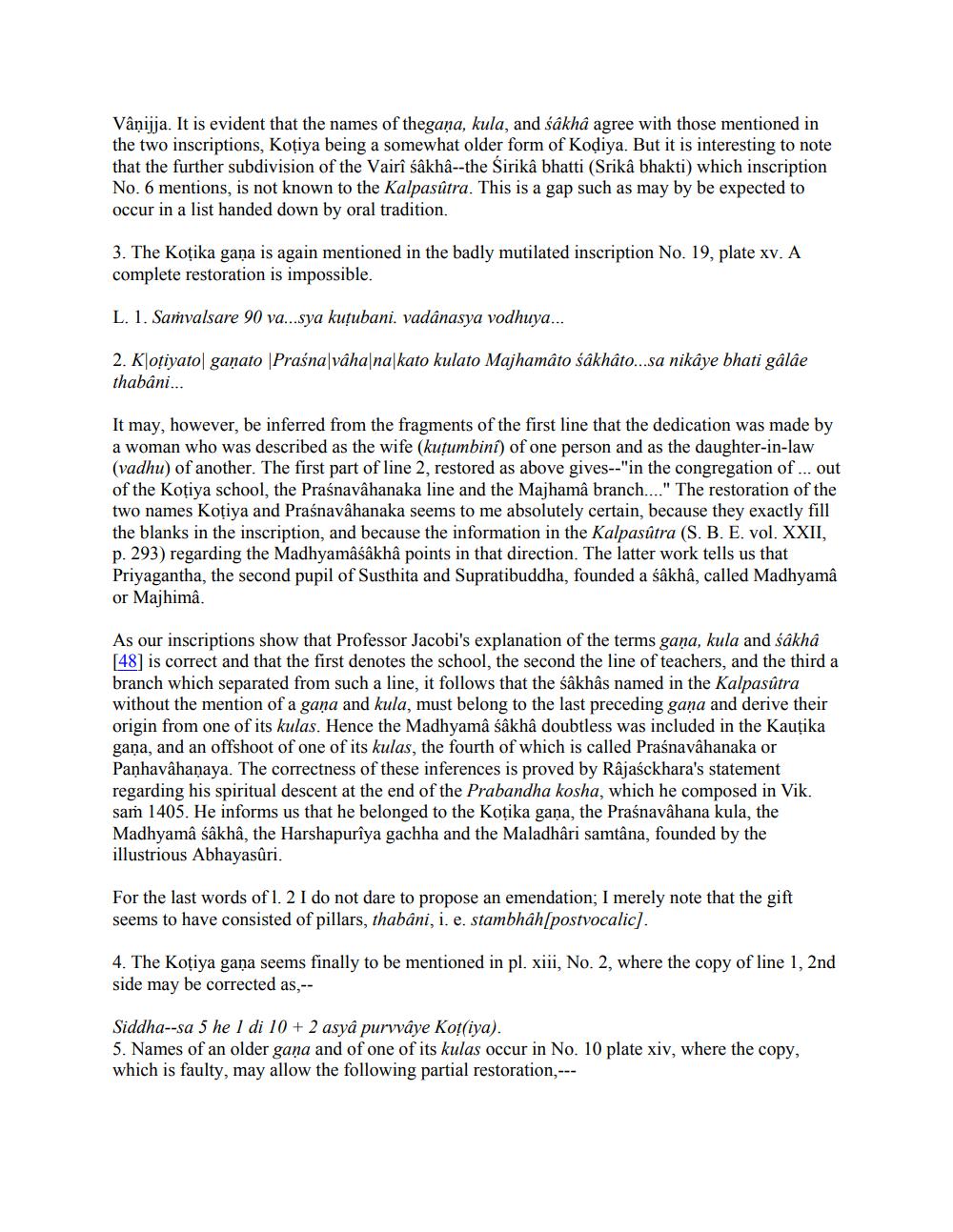________________
Vanijja. It is evident that the names of thegaņa, kula, and sakhâ agree with those mentioned in the two inscriptions, Kotiya being a somewhat older form of Kodiya. But it is interesting to note that the further subdivision of the Vairî sakha--the Sirikâ bhatti (Srika bhakti) which inscription No. 6 mentions, is not known to the Kalpasútra. This is a gap such as may by be expected to occur in a list handed down by oral tradition.
3. The Koţika gana is again mentioned in the badly mutilated inscription No. 19, plate xv. A complete restoration is impossible.
L. 1. Samvalsare 90 va...sya kuțubani. vadánasya vodhuya...
2. K oțiyato gaṇato |Praśna vâha na kato kulato Majhamâto sâkhâto...sa nikâye bhati gâlâe thabani...
It may, however, be inferred from the fragments of the first line that the dedication was made by a woman who was described as the wife (kuțumbini) of one person and as the daughter-in-law (vadhu) of another. The first part of line 2, restored as above gives--"in the congregation of ... out of the Kotiya school, the Praśnavahanaka line and the Majhama branch...." The restoration of the two names Kotiya and Praśnavahanaka seems to me absolutely certain, because they exactly fill the blanks in the inscription, and because the information in the Kalpasútra (S. B. E. vol. XXII, p. 293) regarding the Madhyamâśâkhâ points in that direction. The latter work tells us that Priyagantha, the second pupil of Susthita and Supratibuddha, founded a sâkhâ, called Madhyama or Majhima.
As our inscriptions show that Professor Jacobi's explanation of the terms gana, kula and sakha [48] is correct and that the first denotes the school, the second the line of teachers, and the third a branch which separated from such a line, it follows that the sâkhâs named in the Kalpasútra without the mention of a gana and kula, must belong to the last preceding gana and derive their origin from one of its kulas. Hence the Madhyamâ sâkhâ doubtless was included in the Kautika gana, and an offshoot of one of its kulas, the fourth of which is called Praśnavahanaka or Panhavâhanaya. The correctness of these inferences is proved by Râjaśckhara's statement regarding his spiritual descent at the end of the Prabandha kosha, which he composed in Vik. sam 1405. He informs us that he belonged to the Koţika gana, the Praśnavahana kula, the Madhyama sâkhâ, the Harshapurîya gachha and the Maladhâri samtâna, founded by the illustrious Abhayasûri.
For the last words of l. 2 I do not dare to propose an emendation; I merely note that the gift seems to have consisted of pillars, thabâni, i. e. stambhâh[postvocalic)
4. The Kotiya gana seems finally to be mentioned in pl. xiii, No. 2, where the copy of line 1, 2nd side may be corrected as,--
Siddha--sa 5 he 1 di 10 + 2 asyâ purvvâye Kot(iya). 5. Names of an older gana and of one of its kulas occur in No. 10 plate xiv, where the copy, which is faulty, may allow the following partial restoration ---




